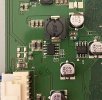Owen Smith
Well-Known Member
My newest and least used HDR Fox T2 now gets stuck at START SYSTEM on the display. I have disconnected the hard disc data and power cables but the problem remains so it isn't the capacitor like I thought. Is there anything I can check or is it just a case of getting my spare out of the loft and hoping it works?


